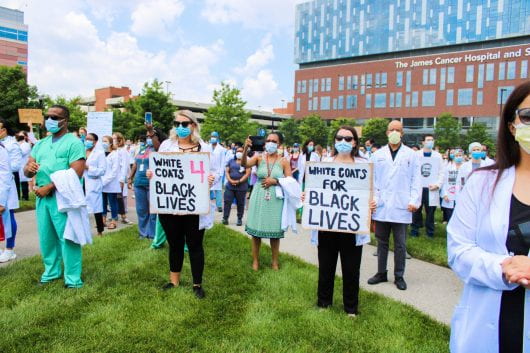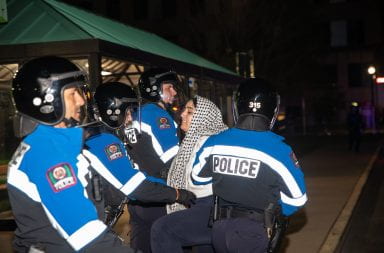
Doctors, nurses and medical students gather outside of the James Cancer Hospital in support of the Black Lives Matter movement June 5. Credit:Courtesy of Rosevine Azap
Dressed in white lab coats, scrubs and surgical masks, doctors, nurses and medical students at the Wexner Medical Center at Ohio State gathered outside the James Cancer Center Friday and took a knee, not only in memory of George Floyd but in protest of systemic racism, especially in health care.
The demonstration, called #WhiteCoatsForBlackLives, was organized by the College of Medicine, the college’s chapter of the Student National Medical Association and the Medical Center to bring awareness to the idea of racism as a public health crisis. About 300 medical students, residents, faculty and staff joined the demonstration.
“As physicians and physicians-in-training, it’s really important for us to understand how the continuous trauma that black and brown communities — that they experience and they face — those are social determinants of health, and they affect them not just in mental ways but in physical ways as well,” Deborah Fadoju, a second-year medical student and chapter president of the Student National Medical Association, said. “Understanding that racism and the devastating consequences that it causes, especially systemic racism, is key for providers to be able to give full and complete care towards all of their patients.”
Fadoju said systemic racism is built into the fabric of the health system with implicit bias. For example, Fadoju said there is a belief that black women have a higher tolerance for pain than women of other races.
“That implicit bias is partially, possibly contributing to the fact that black women die from infant mortality at at least four times the rate of their counterparts,” Fadoju said.
Chelsea Kane, a clinical psychologist at the center, said that implicit bias stems from unconscious stereotypes and the tendency to favor people with whom we identify.
“I, as a white person, am more likely to unknowingly treat white people differently than people who are not white,” she said.
Kane said implicit bias is one of the reasons for the disparities in health care outcomes for black patients. Because implicit bias and racism affect not only the quality of care but also the occurrence of disease, Kane said many medical professionals — herself included — consider racism to be a public health crisis.
She said that not only are rates for cardiovascular diseases and other illnesses higher for black and brown Americans, those patients are more likely to die from these illnesses. Part of that is because the stresses that black Americans — and other groups discriminated against — face in society tend to negatively impact the body and mind. But Kane also said that the same stereotypes and biases that cause that stress also affect treatment.
“Black Americans are underserved when they seek health care,” Kane said. “They are often dismissed from medical facilities without proper medical testing.”
Dr. Quinn Capers, associate dean for admissions and associate professor of cardiovascular medicine at the College of Medicine, conducted a study on implicit biases in medical school admissions to show their effect, according to the College of Medicine website.
In 2012, Capers had all 140 members of the College of Medicine admissions take the Implicit Association Test, which is a widely used, online examination to determine unconscious biases. The results showed that all of the groups that comprise the committee – students, faculty, men and women – had significant implicit biases.
After this admissions cycle, 71 percent of the committee members said the Implicit Association Test could help reduce biases, 48 percent said they were conscious of their individual results when interviewing candidates and 21 percent said their results had an impact on their decisions in the next cycle.
The next class of medical students was the most diverse the College of Medicine had ever seen at the time, Capers said on the College of Medicine website.
While this study was applied to medical school admissions, it could have been an encounter with a patient, Dr. Daniel Clinchot, vice dean for education and chair of the Department of Biomedical Education and Anatomy and co-author of the study, said on the website.
Both Capers and Clinchot said that a key takeaway was that implicit biases can affect behaviors. Capers said in an email there are easy solutions to overcome implicit bias.
“It is quite easy to intentionally override unconscious biases. If one is aware of their biases (or even if they are not), they can slow down, think through every aspect of the decision making process, and discipline yourself to look at only the facts,” Capers said.
Beginning in 2017, Capers has led workshops to educate and ensure awareness of unconscious biases. Capers recommends having admissions committees tested for implicit biases and then discuss and receive training on how to minimize their implicit biases.
Capers found four key strategies to reduce implicit biases: finding a common interest, taking the other person’s perspective, considering the opposite and countering stereotypes.
“Spend time with people whom you admire from groups you may have a bias against. This effort helps connect you with ideas and greater understanding about different communities,” Capers said.
Christine Miguel, a fourth-year medical student, said police use of force stems from larger issues.
“When we think about police brutality and violence at the hands of police, I think it’s unuseful to think about that without thinking about larger structures at play. Why, why do police officers tend to police neighborhoods that are filled with black and brown and low-income bodies?” Miguel said.
As far as Friday’s demonstration, Fadoju said she and other center employees wanted to send a message.
“We stand against two things very firmly,” she said. “Police brutality and its intimately related friend: systemic racism.”


